 Last additions - Hikone 彦根市 Last additions - Hikone 彦根市 |

Mar 26, 2010
|
|

Otsu Hikaru-kun from Otsu, Shiga to promote the 1000th anniversary in 2008 of the novel Genji Monogatari written in Ishiyama-dera temple in Otsu. おおつ光ルくん (滋賀 大津市)Mar 26, 2010
|
|

Mar 26, 2010
|
|

Mar 26, 2010
|
|

Mar 26, 2010
|
|

I still prefer real, human mascots of the feminine kind...Mar 26, 2010
|
|

Mar 26, 2010
|
|

Mar 26, 2010
|
|

Mar 26, 2010
|
|

Mar 26, 2010
|
|

Mar 26, 2010
|
|

Mar 26, 2010
|
|

Mar 26, 2010
|
|

Mar 26, 2010
|
|

Mar 26, 2010
|
|

Mar 26, 2010
|
|

Kabuki-likeMar 26, 2010
|
|

They had a lot more mascot characters than the previous year.Mar 26, 2010
|
|

Hardly anyone patronized the booths. Everyone was busy chasing after and photographing numerous mascot characters. Over 70,000 people attended the festival during the three days. 夢京橋キャッスルロードMar 26, 2010
|
|

Mar 26, 2010
|
|

During the weekend of Oct. 24-25, 2009 on Yume-Kyobashi Castle Road near Hikone Castle, the mascot character festival was held amid product PR booths. ゆるキャラ ふれあい物産展Mar 26, 2010
|
|

Turbo-kun based on pop singer Takanori Nishikawa of T.M. Revolution who hails from Shiga Prefecture. He is an official tourism ambassador for Shiga.Mar 26, 2010
|
|

Mar 26, 2010
|
|

Mar 26, 2010
|
|

Mar 26, 2010
|
|

Musubi-maru to promote tourism in Sendai, Miyagi Pref. Rice ball modeled after Lord Date Masamune. むすび丸 (宮城 仙台市)Mar 26, 2010
|
|

Inflatable mascotMar 26, 2010
|
|

Mar 26, 2010
|
|

One of many cats.Mar 26, 2010
|
|

Mar 26, 2010
|
|

Mar 26, 2010
|
|

Mar 26, 2010
|
|

Mar 26, 2010
|
|

Mito KomonMar 26, 2010
|
|

MailmanMar 26, 2010
|
|

Mar 26, 2010
|
|

Mar 26, 2010
|
|

Mar 26, 2010
|
|

Ninjaemon ninja mascot from Koka, ShigaMar 26, 2010
|
|

Mori from Moriyama, ShigaMar 26, 2010
|
|

Mar 26, 2010
|
|

Mar 26, 2010
|
|

Mar 26, 2010
|
|

Mar 26, 2010
|
|

Mar 26, 2010
|
|

Mar 26, 2010
|
|

Mar 26, 2010
|
|

Mar 26, 2010
|
|

Mar 26, 2010
|
|

PigMar 26, 2010
|
|

Food mascotsMar 26, 2010
|
|

Two catfishes: Magnee (Shiga Lakestars mascot) and Caffy (sports mascot).Mar 26, 2010
|
|

Mar 26, 2010
|
|

Mar 26, 2010
|
|

Hashi Yukio's "Yuru-Kyara Ondo" CD was also on sale in the hall lobby as well as Yuru-kyara books autographed by Miura Jun.Mar 26, 2010
|
|

Meanwhile, outside the Hikone Bunka Plaza Hall were hordes of people crowding around the mascot characters.Mar 26, 2010
|
|

Mar 26, 2010
|
|

Mar 26, 2010
|
|

Mar 26, 2010
|
|

Mar 26, 2010
|
|

Mar 26, 2010
|
|

Mar 26, 2010
|
|

Tabimaru from Kusatsu, Shiga.Mar 26, 2010
|
|

Mar 26, 2010
|
|

Mar 26, 2010
|
|

Mar 26, 2010
|
|

Hiko-nyan and mouse.Mar 26, 2010
|
|

Mar 26, 2010
|
|

Mar 26, 2010
|
|

And there they are on stage in Hikone. Notably absent was Sento-kun from Nara. (Boy priest with antlers.)Mar 26, 2010
|
|

Mar 26, 2010
|
|

Hashi Yukio sings in front of Yuru-Kyara characters in Hikone, Shiga Prefecture. He sang a few numbers.Mar 26, 2010
|
|

Hashi YukioMar 26, 2010
|
|

Hashi Yukio sings the "Yuru-kyara Ondo" in front of Yuru-Kyara characters in Hikone, Shiga Prefecture.Mar 26, 2010
|
|

Hashi Yukio even danced with a few mascot characters.Mar 26, 2010
|
|

Singer Hashi Yukio then appeared on stage.Mar 26, 2010
|
|

Hashi Yukio sings the "Yuru-kyara Ondo" in front of Yuru-Kyara characters in Hikone, Shiga Prefecture.Mar 26, 2010
|
|

Some talking between Hashi and Miura. (The woman is the MC.)Mar 26, 2010
|
|

Mar 26, 2010
|
|

Mar 26, 2010
|
|

Mar 26, 2010
|
|

Mar 26, 2010
|
|

Yuru-kyara mascot characters on stage in Hikone, Shiga Prefecture.Mar 26, 2010
|
|

First they introduced Shiga's mascot characters including Hiko-nyan.Mar 26, 2010
|
|

Then the curtain was lifted to show all the mascot characters as the audience began snapping pictures in a frenzy.Mar 26, 2010
|
|

Shiga's mascot charactersMar 26, 2010
|
|

Then they introduced Miura Jun (right), the man who coined the word "yuru-kyara."Mar 26, 2010
|
|

The 2nd Yuru-kyara festival was held in Oct. 23-25, 2009. The festival was expanded by a day by including an indoor stage show featuring enka singer Hashi Yukio singing "Yuru-kyara Ondo."On Oct. 23, 2009 (Fri.), the Yuru-kyara Daishugo event was held at the Hikone Bunka Plaza's Grand Hall. ひこね市文化プラザ グランドホールMar 26, 2010
|
|

Hikone Bunka Plaza's Grand Hall. Still photography was permitted, but no videos and tripods. The event was a stage show of all the mascot characters appearing on stage. They held three shows on this day. ひこね市文化プラザ グランドホ�Mar 26, 2010
|
|

I attended the 3 pm show which was the only show when famous singer Hashi Yukio would appear and sing with the mascot characters. Admission was 1,000 yen. ゆるキャラ大集合Mar 26, 2010
|
|

The quiet-motor Yakatabune boat is a replica of the daimyo's boat.Jul 02, 2009
|
|

Jul 02, 2009
|
|

Tent selling local goods during spring.Jul 02, 2009
|
|

Near the statue, Hana no Shogai (Flowering Life 花の生涯) monument for Funahashi Seiichi's novel about Naosuke's life that was made into the first NHK Taiga Drama.Jul 02, 2009
|
|

Ride the moat boat on the Inner Moat (内堀) around the Honmaru. Operates once an hour from 10 am to 3 pm. The 45-min. tour has a Japanese guide narrating the sights.Jul 02, 2009
|
|

Jul 02, 2009
|
|

Nigiwai-ichi local goods shop set up in spring.Jul 02, 2009
|
|

Jul 02, 2009
|
|

Path to Nishinomaru in spring. This area is also good for pinicking.Jul 02, 2009
|
|
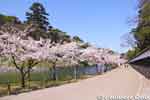
Moat and cherry trees next to Genkyuen Garden.Jul 02, 2009
|
|
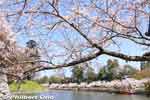
Moat near Genkyuen Garden.Jul 02, 2009
|
|

View from castle tower, looking toward Nishinomaru during cherry blossoms season.Jul 02, 2009
|
|

The castle was finally completed by the Ii clan in 1622. Hikone Castle was the government seat and residence of the Hikone daimyo who ruled the Hikone domain and a few domains in Edo (Tokyo).Jul 02, 2009
|
|

Hikone was important as the crossroads of the Nakasendo Road (中山道) to Kyoto and Hokurikudo Road (北陸道) to the northwest. It also linked the roads to boat transportation on Lake Biwa for Kyoto.Jul 02, 2009
|
|

Central compounds like the Kanenomaru and Honmaru and the main castle tower were completed within a few years and teenager Lord Naotsugu moved in from Sawayama Castle.Jul 02, 2009
|
|

Since Naomasa's son Naotsugu (井伊 直継) was too young, Chief Retainer Kimata Morikatsu (家老 木俣守勝) acted on his behalf to plan the new castle's construction. Upon the approval of Shogun Tokugawa Ieyasu, Mt. Hikone on the shore of Jul 02, 2009
|
|

After the demise of the Tokugawa and the restoration of Imperial rule in 1868, castles were ordered to be demolished. Hikone Castle was also being dismantled when Emperor Meiji visiting in 1878 spared the castle.Jul 02, 2009
|
|
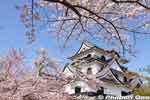
A number of structures were thus saved, including the main castle tower. In 1944, the Ii family donated the castle to the city of Hikone.
Jul 02, 2009
|
|

Many daimyos assisted during the early phase. Most of the structures and stones came from defunct castles in Omi like Otsu, Nagahama, Odani, and Sawayama to reduce the construction time and cost.Jul 02, 2009
|
|

During 1957 to 1960, this castle tower was disassembled and repaired.Jul 02, 2009
|
|

As one of the inner-circle fudai daimyo (譜代大名), the Ii clan continued to be influential in the Tokugawa shogunate.Jul 02, 2009
|
|

Hikone Castle has bell-shaped windows at the top.Jul 02, 2009
|
|

Construction of Hikone Castle started in 1604 as an urgent national project ordered by Ieyasu to deter any rebellious daimyo in western Japan and to protect Kyoto, the Imperial Capital.Jul 02, 2009
|
|

Although it was a military fortress, Hikone Castle never saw battle and was mainly a symbol of authority.Jul 02, 2009
|
|

Hikone Castle is one of five main castle towers in Japan designated as a National Treasure. The others are Himeji, Matsumoto, Matsue, and Inuyama Castles.Jul 02, 2009
|
|

Hikone Castle's main tower is said to be originally the castle tower for Otsu Castle whose lord was Kyogoku Takatsugu. It was moved here in 1606. This main tower is designated as a National Treasure.Jul 02, 2009
|
|

Although it was the most prominent building, the daimyo did not live in it. It was mainly a glorious symbol and storehouse for samurai armor and other artifacts of past Hikone daimyo.Jul 02, 2009
|
|

Finally you see the main castle tower or Tenshukaku. Hikone Castle was completed in 1622 after 20 years of construction by Lord Ii Naotsugu who started building the caslte in 1603 upon his deceased father Naomasa's wish.Jul 02, 2009
|
|

Steps leading to Taikomon Gate. Before that, you can pay to have tea under the red umbrella front of the tea house and Time-Keeping Bell.Jul 02, 2009
|
|

Right side of Tenbin Yagura turret in spring with cherry blossoms.Jul 02, 2009
|
|

Time when Hiko-nyan (Hikone's official mascot) will appear today.Jul 02, 2009
|
|

The info sign also has a sticker with a QR code to be read by your compatible cell phone. You can then access the respective URL and see more information.Jul 02, 2009
|
|

Tenbin Yagura turret in spring. This is also one location where the film Idai Naru, Shurararabon (偉大なる、しゅららぼん The Great Shu Ra Ra Boom) was filmed.Jul 02, 2009
|
|

Entrance to castle. The ticket office is where you pay castle admission. You can also buy a ticket set which includes admission to Genkyuen Garden (recommended). Open 8:30 am to 5 pm.Jul 02, 2009
|
|

Omotemon Bridge and Gate 表門Jul 02, 2009
|
|

Omotemon Bridge and cherry blossomsJul 02, 2009
|
|

Omotemon BridgeJul 02, 2009
|
|

Jul 02, 2009
|
|

Iroha-matsu pine tree and sakuraJul 02, 2009
|
|

Castle moat and Ninomaru-Sawaguchi Tamon Yagura Turret. Hikone Castle was home to a total of 14 Ii lords until Ii Naosuke. The Ii family remained close to the Tokugawa and the family head traditionally served as the Tokugawa government's Chief MinistJul 02, 2009
|
|

Since the construction of Hikone Castle was designated as a national project by the Tokugawa government, as many as 12 daimyo lords were ordered to assist in the construction.Jul 02, 2009
|
|

Ninomaru-Sawaguchi Tamon Yagura Turret and cherry blossoms. Tamon yagura were long corridor-type turrets.Jul 02, 2009
|
|

Sign says Hikone Castle is one of the "Omi Hakkei" or Eight Views of Omi.Jul 02, 2009
|
|
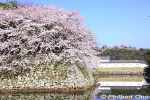
In 1606, the 1st and 2nd phases of Hikone Castle's construction were completed. The tenshu castle tower was also completed and Naokatsu moved in. This is the Castle moat and Ninomaru-Sawaguchi Tamon Yagura Turret.Jul 02, 2009
|
|

Hikone Castle was built with many structures and materials transferred other Shiga castles such as Otsu Castle, Nagahama Castle, Odani Castle, Kannonji, and Sawayama Castle. This greatly reduced the cost and time required to complete the castle.Jul 02, 2009
|
|

Moat as seen from Ninomaru-Sawaguchi Tamon Yagura Turret in spring.Jul 02, 2009
|
|

The right side of the turret is now the Kaikoku Kinenkan museum.Jul 02, 2009
|
|

Jul 02, 2009
|
|

In 1616, the construction's 3rd phase was begun to build the castle palace. Construction was henceforth carried out by local Hikone workers without outside help. The castle construction was completed in 1622.Jul 02, 2009
|
|

Cherry blossoms, castle moat, and Ninomaru-Sawaguchi Tamon Yagura Turret.Jul 02, 2009
|
|

From the Iroha pine tree road, you will see this Ninomaru-Sawaguchi Tamon Yagura Turret.Jul 02, 2009
|
|

Sign says Hikone Castle is one of the "Omi Hakkei" or Eight Views of Omi in spring.Jul 02, 2009
|
|
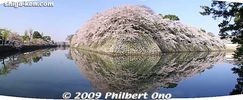
Come in the early morning and see Hikone Castle's moat water give a mirror reflection of the cherry blossoms. It's really beautiful on a sunny morning.Jul 02, 2009
|
|

Naomasa's son Naokatsu was still an infant when Naomasa died. So Naomasa chief retainer consulted with Shogun Tokugawa Ieyasu and it was decided to build a new castle at the present location. Construction started in 1603.Jul 02, 2009
|
|

Hikone Castle moat and cherry blossoms.Jul 02, 2009
|
|

At the intersection, straight ahead is Gokoku Shrine (護国神社) dedicated to Shiga's war dead. You can go through the shrine or turn left toward Hikone Castle.Jul 02, 2009
|
|

Statue of Lord Ii Naomasa (井伊 直政 1561-1602 ) in front of JR Hikone Station in 2007.Jan 12, 2009
|
|

Hikone Castle tower lit up at night.Jan 12, 2009
|
|

Hikone Castle as seen from Genkyu-en Garden. Genkyu-en is a Japanese garden next to the castle.Jan 12, 2009
|
|

Map of Hikone Castle as it is today.Jan 12, 2009
|
|

Hikone Castle tower lit up at night.Jan 12, 2009
|
|

Hikone Castle as seen from Genkyuen Garden during autumn at night.Jan 12, 2009
|
|
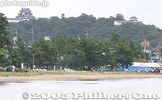
Hikone Castle as seen from Matsubara Beach.Jan 12, 2009
|
|

Ii Naosuke (井伊 直弼) (1815-1860) was the Tokugawa shogunate's Chief Minister (Tairo) who favored and concluded commercial treaties with the Western powers and thus broke Japan's isolation from the world.Jan 12, 2009
|
|
|

Moat as seen from Kuromon Gate.Jan 12, 2009
|
|
|
|

You can walk further to go behind Nishinomaru Sanju-yagura turret and this is what you will see.Jan 12, 2009
|
|

Statue of Ii Naosuke near the Hikone Castle moat. Lord of the castle and also an important historical figure. 井伊 直弼Ii Naosuke was the Tokugawa shogunate's Chief Minister (Tairo) who favored and concluded commercial treaties with the Western powers and thus broke Japan's isolation from the world. Foreigners were then allowed to trade with Japan and take up residence in cities like Yokohama and Hakodate. Ii was later assassinated in 1860 by samurai radicals from Mito (Ibaraki) who sought to oust the foreign "barbarians." Jan 12, 2009
|
|

Jan 12, 2009
|
|

Hikone Castle moat in autumn from Kyobashi Bridge.Jan 12, 2009
|
|

After visiting the Hikone Castle Tower. There are a few ways to exit. One way is going through this Otemon Gate to Kyobashi Bridge.Jan 12, 2009
|
|

Another exit is this Kuromon Gate. This might be a better exit if you also want to visit Genkyuen Garden (recommended). 黒門Jan 12, 2009
|
|

Jan 12, 2009
|
|

Rear view of Nishinomaru Sanju-yagura turret.Jan 12, 2009
|
|

Inside Nishinomaru Sanju-yagura turret.Jan 12, 2009
|
|

Lake Biwa as seen from Nishinomaru.Jan 12, 2009
|
|
|

Behind Nishinomaru Sanju-yagura turret.Jan 12, 2009
|
|

Jan 12, 2009
|
|

Nishinomaru Sanju-yagura turret.Jan 12, 2009
|
|

Nishinomaru Sanju-yagura turret.Jan 12, 2009
|
|

Kyobashi Bridge goes to Yume-Castle Road which is a street of local shops and restaurants. In the moat, you might see a few black swans which were gifts from Mito, Ibaraki Prefecture.Jan 12, 2009
|
|

Kyobashi Bridge 京橋Jan 12, 2009
|
|

Moat of Nishinomaru Sanju-yagura turret.Jan 12, 2009
|
|

Jan 12, 2009
|
|

Jan 12, 2009
|
|

No nailsJan 12, 2009
|
|

Inside Nishinomaru Sanju-yagura turret. Quite authentic.Jan 12, 2009
|
|

Nishinomaru Sanju-yagura turret.Jan 12, 2009
|
|

Beam joint inside Nishinomaru Sanju-yagura turret.Jan 12, 2009
|
|

Nishinomaru Sanju-yagura turret. This turret is usually closed to the public, but opened during the 400th anniversary in 2007.Jan 12, 2009
|
|

Nishinomaru Sanju-yagura turret. "Sanju" means three stories. You can see the 3-story turret and go up the 2nd and 3rd floors.Jan 12, 2009
|
|

Inside Nishinomaru Sanju-yagura turret. (Important Cultural Property)Jan 12, 2009
|
|

Nishinomaru Sanju-yagura turret. This turret is said to have formerly been the tenshu castle tower of Odani Castle in Nagahama. 西の丸三重櫓Jan 12, 2009
|
|

After seeing the main castle tower, walk behind it to also see the Nishinomaru keep. This is the rear view of Hikone Castle's main tenshu tower as seen from Nishonomaru in fall.Jan 12, 2009
|
|

Rear of castle tower.Jan 12, 2009
|
|

Behind the castle tower is Nishinomaru keep which is west of the castle tower.Jan 12, 2009
|
|

If you walk further, you will see Nishinomaru Sanju-yagura turret.Jan 12, 2009
|
|

View from castle tower, Takeshima in Lake Biwa. Takeshima is a small island near Hikone. 多景島 Photos here.Jan 12, 2009
|
|

The castle tower is not as large as Himeji or Matsumoto, but the construction on the inside is original.Jan 12, 2009
|
|

View from castle towerJan 12, 2009
|
|

Top floor ceiling.Jan 12, 2009
|
|

Jan 12, 2009
|
|
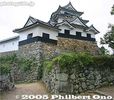
The rear of the castle tower.Jan 12, 2009
|
|

Jan 12, 2009
|
|

Jan 12, 2009
|
|

View from Hikone Castle towerJan 12, 2009
|
|

Entrance to castle towerJan 12, 2009
|
|

Entrance to tower. There are a few very steep staircases. Wearing high heels and miniskirts are not recommended.Jan 12, 2009
|
|

CorridorJan 12, 2009
|
|

Top floor. The windows are small and it's difficult to get a good shot of the view. There is also no balcony to go outside on the top floor.Jan 12, 2009
|
|

Ceiling of Hikone Castle tower.Jan 12, 2009
|
|

CorridorJan 12, 2009
|
|
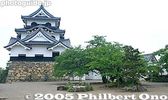
Hikone Castle is a designated Special National Historic Place (特別史跡).Jan 12, 2009
|
|

Front view of Hikone Castle tower 天守閣Jan 12, 2009
|
|

Jan 12, 2009
|
|

Inside Taikomon Gate.Jan 12, 2009
|
|
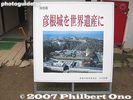
Sign outside the Taikomon Gate indicating the city's project to have Hikone Castle be designated as a World Heritage Site.Jan 12, 2009
|
|
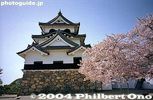
Jan 12, 2009
|
|

Time-Keeping Bell. The bell was recast in 1844. 時報鐘 - Jihosho. Next to the bell is a tea house called Choshoan. The 13th lord of the castle, Ii Naosuke was a diligent practitioner of the tea ceremony.The famous phrase "Ichigo Ichie" (One Encounter, One Chance) was coined by him in a tea ceremony book titled "Chanoyu Ichie-shu" (茶の湯一会集).Jan 12, 2009
|
|

You can enter Taikomon Gate which is an exhibition room for photos of Japanese castles and a model of Hikone Castle.Jan 12, 2009
|
|

Steps to Taikomon Gate.Jan 12, 2009
|
|

Path to Taikomon Gate.Jan 12, 2009
|
|

Taikomon Yagura Turret. This is the gate right before you reach the main castle tower. "Taikomon" means Taiko Drum Gate. It had a taiko drum that was beaten to convey signals to the inner castle. Important Cultural Property. 太鼓門Jan 12, 2009
|
|

Time-Keeping Bell or Jiho-sho. It is rung five times daily at 6:00, 9:00, 12:00 noon, 15:00, and 18:00. Also see my YouTube video here.Jan 12, 2009
|
|

Rear view of Tenbin Yagura turret. The middle door also serves as an entrance.Jan 12, 2009
|
|

Steps to Taikomon Gate.This is also one location where the film Idai Naru, Shurararabon (偉大なる、しゅららぼん The Great Shu Ra Ra Boom) was filmed. Where Kiyoko rides her horse up the steps.Jan 12, 2009
|
|

Rear view of Tenbin Yagura turret. Jan 12, 2009
|
|

Under the right turret inside Tenbin Yagura. Stairway (closed to public) to 2nd floor of right turret.Jan 12, 2009
|
|

Tenbin Yagura's right side has natural, unshaped stones (gobo-zumi 牛蒡積み) with small stones in the gaps.Jan 12, 2009
|
|

View of the bridge from Tenbin Yagura turret.Jan 12, 2009
|
|

View of the bridge from Tenbin Yagura turret.Jan 12, 2009
|
|
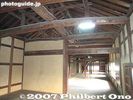
Inside Tenbin Yagura turret now open to the public since 2007.Jan 12, 2009
|
|
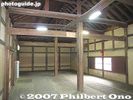
Jan 12, 2009
|
|
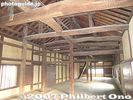
Inside Tenbin Yagura turretJan 12, 2009
|
|

The tenbin Yagura turret is said to have come from Nagahama Castle. (Important Cultural Property) 天秤櫓Jan 12, 2009
|
|

Tenbin Yagura's left side has shaped stones fitting together using a newer technique (otoshi-zumi 落し積み) when repaired in 1854. Jan 12, 2009
|
|

Inside Tenbin Yagura turret, looking toward the left turret.Jan 12, 2009
|
|

Left end of Tenbin Yagura turret.Jan 12, 2009
|
|

Tenbin Yagura turret on the left.Jan 12, 2009
|
|

Tenbin YaguraJan 12, 2009
|
|

Rokabashi Bridge (廊下橋) going to the Tenbin Yagura (天秤櫓) could be demolished in case of enemy attack. Tenbin Yagura's stone wall differs between the left and right.Jan 12, 2009
|
|

Omotezaka Path to castle tower. Not good for wheel chairs or those who don't like to climb stairs.Jan 12, 2009
|
|

Jan 12, 2009
|
|

Also this garden for the daimyo.Jan 12, 2009
|
|

Bridge to Tenbin Yagura turretJan 12, 2009
|
|

Under the bridge to Tenbin Yagura turret.Jan 12, 2009
|
|

Rokabashi Bridge (廊下橋) goes to the Tenbin Yagura (天秤櫓) whose stone wall differs between the left and right.Jan 12, 2009
|
|

Under the bridge to Tenbin Yagura turret.Jan 12, 2009
|
|

Entrance to Hikone Castle Museum. A reconstruction of the castle palace completed in 1987 to mark Hikone city's 50th anniversary. Admission charged.Jan 12, 2009
|
|

The Hikone Castle Museum replicated the daimyo's living quarters that included this tea ceremony room.Jan 12, 2009
|
|

Kadomatsu decoration for New Year's. Hikone Castle Museum is in the background. During New Year's, they served free hot ama-zake (sweet sake) to all visitors.Jan 12, 2009
|
|

Omotemon BridgeJan 12, 2009
|
|

Jan 12, 2009
|
|

In one Tora-san movie (starring Atsumi Kiyoshi) made in 1982, this is where he sold his goods.Jan 12, 2009
|
|

Behind the horse stable.Jan 12, 2009
|
|

The stable is in remarkable condition, and the only one in Japan existing within a castle grounds.Jan 12, 2009
|
|

The left building is an Important Cultural Property rebuilt in 1771. It has a corner turret on the left end and we used to be able to enter it through a side entrance from behind. Jan 12, 2009
|
|

Behind the rebuilt Ninomaru-Sawaguchi Tamon Yagura Turret, now the Kaikoku Kinenkan museum.Jan 12, 2009
|
|

Inside Umaya Horse Stable, open to the public for the 400th anniversary onward in 2007.Jan 12, 2009
|
|

Dummy horse in the horse stable.Jan 12, 2009
|
|
| 1077 files on 5 page(s) |
 |
3 |  |
|